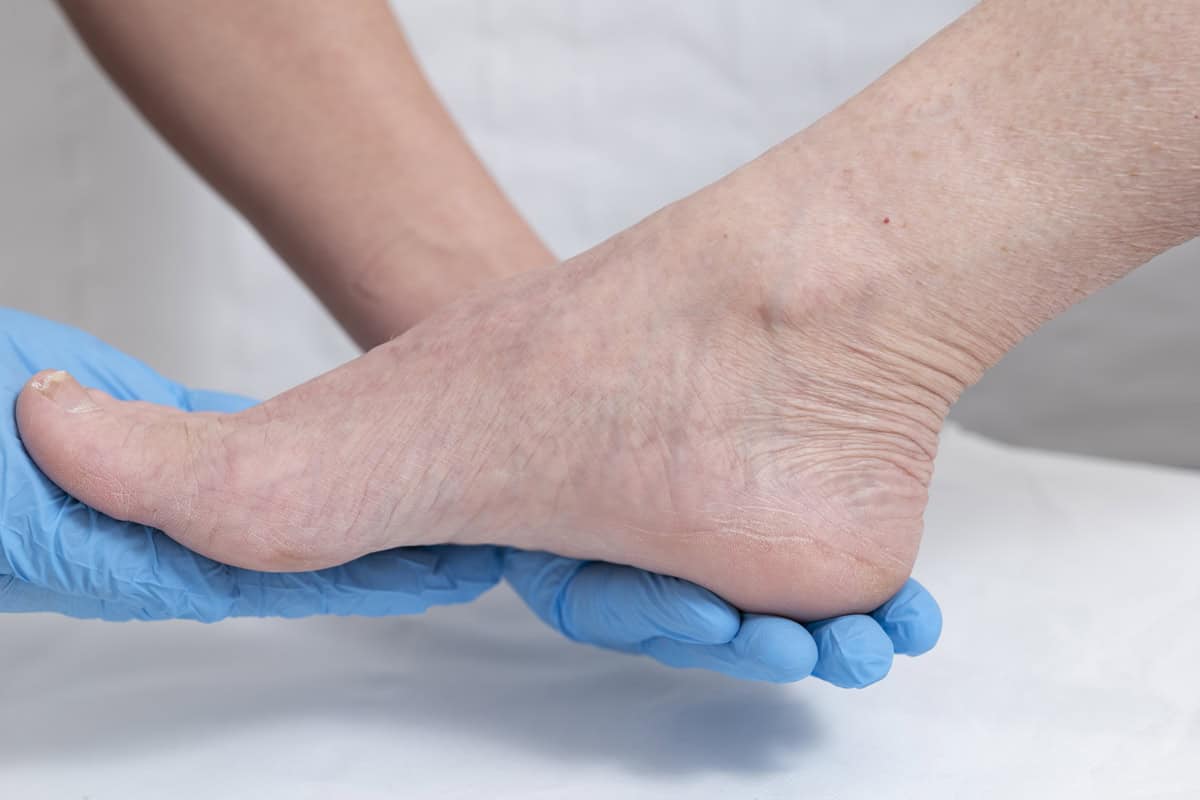Why Am I Experiencing Sudden Ankle Pain Without Injury or Swelling?
Sudden ankle pain without injury of swelling may seem surprising, however there are a number of explanations for this strange phenomenon. Our Brisbane and Mount Isa podiatrists are adept at treating foot problems and ankle pain as well as leg pain, and we know that intense pain does not always need a distinct injury to occur. So let’s run through the many causes you may be experiencing ankle pain without a known injury and what treatment a podiatrist can provide.
TL;DR (Too Long; Didn’t Read)
Sudden ankle pain without injury or swelling can result from common complaints and issues such as nerve compression (tarsal tunnel syndrome), tendon inflammation (tendinopathy), ligament strain, arthritis, referred pain from the back or legs, or circulation problems. Because the ankle is a complex structure of muscles, tendons, nerves, and ligaments, pain can appear even without a clear injury.
Treatment depends on the cause and may include orthotic support, physical therapy, shockwave or laser therapy, and in some cases, a CAM walker (moon boot) to offload pressure and allow healing. Persistent pain should be assessed by a podiatrist, who can provide medical attention, a thorough diagnosis and targeted treatment plan backed by clinical evidence to restore comfort and mobility.
Ankle Anatomy
To understand why you may be experiencing a painful ankle, it’s important to have a basic understanding of the surrounding muscles, nerves, ligaments and joints which are involved.
The ankle is a tri-plane joint, meaning it can move in three planes of motion (frontal, sagittal, transverse). This essentially means the ankle can bend ‘up and down’, roll ‘in and out’, and also has a small ‘side to side’ motion where it can rotate your foot towards and away from the midline of your body. The two main functions of the ankle are the ‘up and down’ (plantarflexion and dorsiflexion) and ‘roll in and out’ (inversion and eversion) movements, which are the primary movements which help you walk and keep your balance.
To achieve these movements, there are multiple muscles and tendons in your lower leg which help to move the ankle joint; namely the tibialis posterior, tibialis anterior, gastrocnemius (calf muscles), Achilles tendon and peroneals. Supporting the ankle joint itself are a range of ligaments, which support the bones, hold them in place, and stop them moving beyond their normal end range of motion. Every muscle, tendon and ligament works in a complex balance, and ankle joint is responsible for balancing and moving our entire body weight. The ankle joint also contains the important ‘tarsal tunnel’, where the main nerve, artery and vein supplying the foot runs. To put it simply – there is a lot going on in that one little area! This unfortunately also means there is a fair bit that can go wrong.
Causes of Ankle Pain without Injury
If you’re experiencing ankle pain without any obvious injury, there are several possible causes. Let’s look at some of the most frequent explanations.
Nerve Compression or Irritation (Tarsal Tunnel Syndrome)
One common cause of ankle pain without swelling or injury is tarsal tunnel syndrome. This condition occurs when the tibial nerve becomes compressed within the tarsal tunnel, a narrow space along the inside of the ankle.
Symptoms can include:
- Burning, tingling, or shooting pain in the ankle or foot
- Numbness along the sole
- Pain that worsens with activity or at night
Because nerve pain doesn’t always cause visible swelling, it’s often mistaken for a tendon or joint problem. Early diagnosis and treatment are important to prevent permanent nerve damage.
Tendon Inflammation (Tendonitis)
Tendonitis (irritation or swelling) of the tendons, can cause ankle pain even when you haven’t had an injury. It usually develops over time from overuse, poor footwear, or sudden increases in activity.
The Achilles, peroneal, and tibialis posterior tendons are common culprits.
Typical signs include:
- Dull or aching pain around the ankle
- Stiffness after rest or in the morning
- Pain that worsens with walking or exercise
Left untreated, tendinopathy can progress into chronic pain or partial tearing.
Subtle Joint or Ligament strain
Even without a clear injury, repetitive micro-strains or biomechanical imbalances can stress the ankle’s supporting structures. Poor posture, weak stabilising muscles, or unsupportive shoes can all lead to ligament strain or mild joint irritation.
You may be more at risk if you commonly:
- Stand for long hours on hard floors
- Wear high heels or flat shoes with no arch support
- Have flat feet or very high arches
- Play sports with repetitive ankle movement
A biomechanical assessment by a podiatrist can identify these contributing factors and guide corrective treatment. In severe cases, they may recommend complete immobilisation, however most cases can be treated conservatively with custom orthotics.
Arthritis or Joint Degeneration
Osteoarthritis or inflammatory arthritis (like rheumatoid arthritis or gout) can affect the ankle and cause pain even when there’s no swelling or visible injury.
Other symptoms may include:
- Deep, aching pain
- Stiffness, especially in the morning
- Reduced range of motion
- Redness on the skin around joints, particularly around toes
- Co-occurring hip, knee and leg pain
Even mild cartilage wear can make walking or standing uncomfortable. Addressing arthritis early can help preserve joint function and reduce pain. Your podiatrist may refer you back to your doctor for a blood test if they suspect an inflammatory arthritis. Treatment options may include oral medications such as NSAID medication (e.g. ibuprofen), pain killing medication (e.g. paracetamol), uric acid reducing medication, joint mobilisation, or joint splinting.
Referred Pain from the Back or Legs
Sometimes, ankle pain doesn’t originate in the ankle at all. Nerves problems from the lower back, knee, or leg muscles can refer pain downward to the ankle area and even into the toes.
This type of pain is often caused by:
- Sciatica (nerve compression in the spine)
- Tight calf or hamstring muscles
- Entrapped peripheral nerves
A podiatrist can perform neurological and gait assessments to pinpoint whether the source of your painful symptoms is local or referred.
Circulation or Vascular Problems
Poor blood circulation can also lead to ankle discomfort without swelling. Conditions like peripheral arterial disease (PAD) result in poor circulation to the feet and lower legs.
Warning signs and symptoms include:
- Aching or cramping pain
- Pale or cool skin
- Slow healing of small cuts or blisters
- Varicose veins around the ankle or ‘bruising appearance’ on skin
- History of blot clots / DVT
If these symptoms sound familiar, it’s important to seek medical evaluation promptly. In the event of a sudden sharp pain, aching legs, and swollen legs, a blood clot is possible. Your podiatrist may do blood flow tests to determine if this is a cause for you.
Assessing Ankle Pain
Persistent ankle pain deserves professional attention. At Advance Foot Clinic Podiatry, our Brisbane and Mount Isa podiatrists perform a thorough evaluation to determine the exact cause of your pain. This may include:
- Physical assessment of joint motion, range and feel
- Gait analysis to assess walking patterns
- Imaging (X-ray, ultrasound, or MRI) to detect soft tissue or bone issues
- Vascular and nerve testing if poor circulation or nerve irritation is suspected
A precise diagnosis allows for a tailored treatment plan to relieve pain and prevent recurrence.
Treatment Options for Ankle Pain Without Injury
The best treatment depends on the cause of your pain, but several approaches can provide relief and support healing.
Footwear and Orthotic Support
Supportive, well-fitted footwear can significantly reduce strain on your ankles. Custom orthotics may be prescribed to correct biomechanical issues, redistribute pressure, and stabilise your gait. For ankle injuries, the focus will be on reducing unnecessary motion at the ankle and keeping the sub-talar joint in a neutral position.
Physical Therapy and Strengthening
Targeted exercises can strengthen weak muscles and improve joint stability. Stretching tight calf muscles can also help alleviate stress on the ankle.
Shockwave Therapy
Shockwave therapy is a non-invasive treatment that stimulates healing by increasing blood flow and cell activity in damaged tissues. It is particularly helpful for chronic tendon pain and is safe to use from teenagers up to older adults.
Laser Therapy
Low-level laser therapy reduces inflammation and accelerates tissue repair, making it useful for both nerve-related and overuse ankle pain. Laser therapy can only be provided by a medical professional such as a general practitioner or one of our Brisbane and Mt Isa podiatrists. If laser therapy is provided as part of a prompt treatment regime, it can drastically improve recovery time.
Using a CAM Walker (Moon Boot)
For some patients, a Controlled Ankle Motion (CAM) walker, also called a moon boot, can be a valuable part of the treatment plan.
This medical boot helps immobilise the ankle, reducing movement and giving injured tissues time to heal. Unlike traditional casts, CAM walkers are adjustable and removable, allowing better comfort, hygiene, and flexibility.
Benefits of a CAM Walker include:
- Stabilising the ankle and reducing pain
- Offloading pressure from irritated tendons or ligaments
- Supporting microfractures or overuse injuries
- Allowing safe, controlled walking during recovery
Your podiatrist will determine if a CAM walker is appropriate and guide you on how long it should be worn for optimal results.
When to See a Podiatrist
You should book an appointment with a podiatrist if your ankle pain:
- Persists for more than a few days
- Affects walking or balance
- Is accompanied by numbness, tingling, or burning
- Feels stiff or unstable
- Returns despite rest and supportive shoes
Sudden ankle pain without injury or swelling can be puzzling, but it’s rarely without reason. Because the ankle is such a complex and weight-bearing joint, even small structural, nerve, or circulatory changes can lead to discomfort.
If you’re dealing with unexplained ankle pain, the team at Advance Foot Clinic Podiatry can help. With clinics across Brisbane and Mount Isa, our experienced podiatrists will assess, diagnose, and provide effective treatment options tailored to your needs so you can get back on your feet comfortably and confidently.


